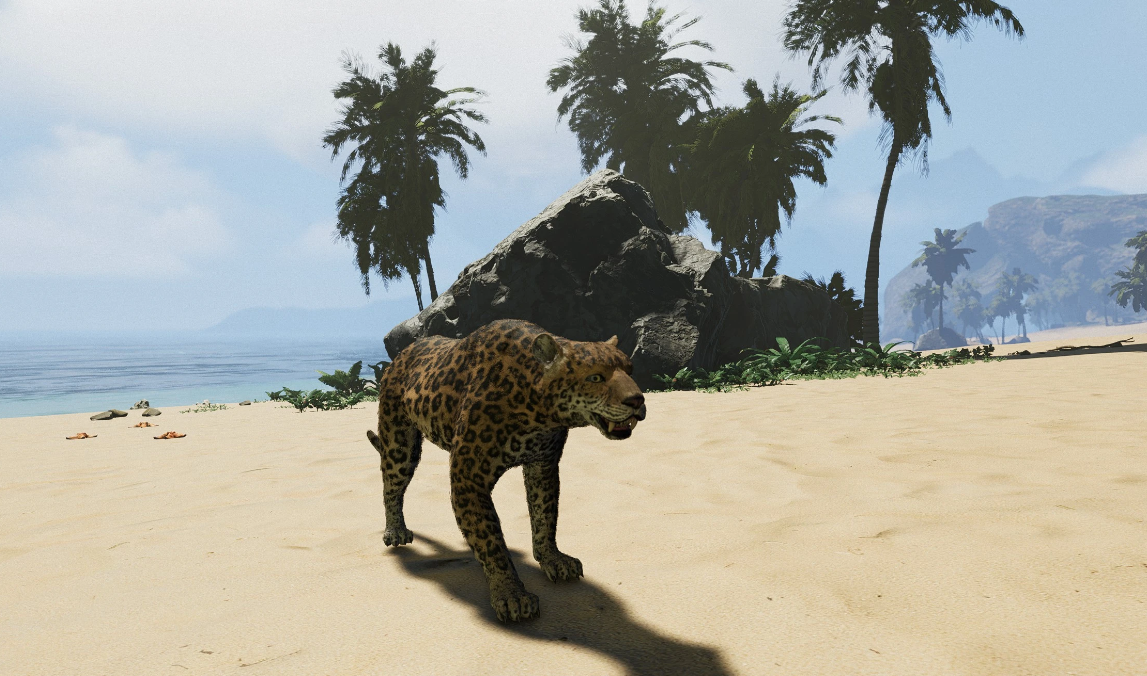Jaguars (Panthera onca) are the largest big cats in the Americas and symbolize strength, beauty, and power in the wild. Their distinctive golden-yellow coats, marked with black rosettes, make them one of the most recognizable animals on Earth. Known for their stealthy hunting skills and impressive physical abilities, jaguars are found in various habitats, from dense rainforests to open grasslands.
These majestic cats are more than just symbols of beauty; they are crucial players in maintaining the health of ecosystems. Jaguars control prey populations and help sustain biodiversity, making their survival essential to the balance of nature.
What Are the Physical and Sensory Characteristics of Jaguars?
Jaguars are perfectly adapted for their roles as apex predators. Their physical traits make them one of nature’s most effective hunters.
Physical Characteristics:
- Size: Adult jaguars typically weigh between 100 and 250 pounds, with males being larger than females. They can reach lengths of up to 6 feet, not including their long tails.
- Coat: The distinctive golden-yellow fur, covered with black rosettes and spots, provides excellent camouflage in their forested environments.
- Jaw Strength: Jaguars have one of the strongest bites in the animal kingdom, capable of crushing turtle shells and biting through bone. This immense jaw power allows them to take down larger prey with precision.
Sensory Abilities:
- Vision: Jaguars have excellent night vision, allowing them to hunt efficiently in low-light conditions.
- Hearing: Their acute sense of hearing helps them detect prey and potential threats from long distances, making them formidable nocturnal hunters.
Where Do Jaguars Live, and What Habitats Do They Prefer?
Jaguars inhabit a wide range of environments, primarily in Central and South America. Their ability to thrive in diverse habitats underscores their adaptability.
Geographic Distribution:
- Central America: Jaguars are found from southern Mexico through the tropical regions of Central America.
- South America: They are most commonly found in the Amazon rainforest, the Pantanal, and parts of the Andes.
Preferred Habitats:
- Rainforests: The dense foliage of rainforests provides cover for jaguars to stalk their prey. These environments also offer an abundance of water sources, which is critical for their hunting habits.
- Wetlands: Jaguars are strong swimmers and often hunt in swamps or along riverbanks, preying on caimans, fish, and other aquatic animals.
How Do Jaguars Hunt and What Is Their Diet?
As apex predators, jaguars have a varied diet and use specific hunting techniques to capture their prey.
Diet:
Jaguars have a diverse diet that includes:
- Mammals: Such as capybaras, peccaries, and deer.
- Reptiles: They frequently hunt caimans and large snakes.
- Fish: Jaguars are known to dive into rivers to catch fish, showcasing their unique hunting adaptability.
Hunting Techniques:
- Stalking: Jaguars use their camouflage to move stealthily through their environment, getting as close as possible to their prey before attacking.
- Ambush: They often launch surprise attacks from trees or tall grass, relying on their incredible speed and strength to overpower their prey.
- Bite Technique: Unlike most big cats that target the neck, jaguars kill their prey with a powerful bite through the skull, ensuring a quick and efficient kill.
What Is the Social Structure and Behavior of Jaguars?
Jaguars are largely solitary creatures with a distinct social structure and behavioral patterns that are key to their survival.
Solitary Nature:
- Territorial Behavior: Male jaguars establish large territories that often overlap with female ranges. While jaguars are solitary, males and females come together during mating season.
- Marking Territory: Jaguars mark their territories using scent markings and claw marks on trees, signaling their presence to other jaguars.
Communication:
Jaguars communicate through various means, including vocalizations, scent marking, and visual cues. Their distinctive roars can be heard over long distances, especially during the mating season.
Why Are Jaguars Important to Their Ecosystems?
Jaguars play a crucial role in their ecosystems, impacting prey populations and promoting biodiversity.
Apex Predator:
As apex predators, jaguars regulate the populations of herbivores, preventing overgrazing and promoting vegetation growth. This balance is essential for maintaining healthy ecosystems.
Keystone Species:
Jaguars are considered a keystone species, meaning their presence is critical for maintaining the structure of their ecological community. If jaguars were to disappear, the entire ecosystem could suffer, leading to overpopulation of certain species and a decline in biodiversity.
What Are the Main Threats to Jaguar Populations?
Despite their status as apex predators, jaguars face several threats that jeopardize their survival.
Habitat Loss:
- Deforestation: Deforestation due to logging and agriculture is one of the biggest threats to jaguar populations, leading to the destruction of their natural habitats.
- Urbanization: As cities expand, jaguar habitats are fragmented, forcing them into smaller, less suitable areas.
Poaching and Illegal Trade:
- Hunting: Jaguars are often hunted for their pelts and body parts, which are used in traditional medicine.
- Human Conflict: When jaguars prey on livestock, farmers may retaliate by hunting them, further diminishing their numbers.
Climate Change:
Changing environmental conditions affect jaguar habitats, particularly in terms of prey availability and habitat stability. As climate change continues to alter ecosystems, jaguars are left with fewer resources to survive.
What Conservation Efforts Are in Place to Protect Jaguars?
Conservation organizations and governments are working to protect jaguars and their habitats through various initiatives.
Protected Areas:
- National Parks and Reserves: Establishing protected areas is crucial for safeguarding jaguar habitats, allowing them to roam and hunt freely.
- Wildlife Corridors: Connecting fragmented habitats with wildlife corridors enables jaguars to move across larger territories, maintaining genetic diversity and reducing the risk of inbreeding.
Community Engagement:
- Local Initiatives: Involving local communities in conservation efforts promotes coexistence between humans and jaguars.
- Education: Raising awareness about the importance of jaguars in ecosystems fosters a culture of conservation.
How Can You Help Protect Jaguars?
You don’t have to be a wildlife expert to make a difference in jaguar conservation. Here are some ways you can contribute:
Support Conservation Organizations:
- Donations: Contributing to organizations focused on jaguar conservation can have a significant impact.
- Volunteer: Look for opportunities to volunteer for wildlife conservation projects, either locally or internationally.
Raise Awareness:
- Educate Others: Share information about the importance of jaguars and their ecosystems with your friends, family, and social media followers.
- Advocate for Change: Support policies that protect wildlife and their habitats.
Make Sustainable Choices:
- Responsible Consumption: Choose products that are sustainably sourced and support conservation efforts.
- Reduce Your Footprint: Participate in initiatives aimed at reducing deforestation and promoting sustainable land use.
Conclusion: Why Should We Protect Jaguars?
Jaguars are magnificent creatures with a vital role in maintaining the health of ecosystems. By understanding their behaviors, habitats, and the threats they face, we can take meaningful steps to protect them. Supporting conservation efforts, raising awareness, and making sustainable choices are all ways we can contribute to safeguarding the future of jaguars. Together, we can ensure that these apex predators continue to thrive, preserving not only their species but also the ecosystems they help sustain.










